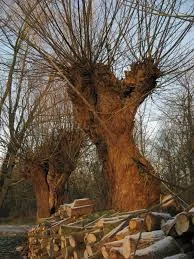Willow
Willow
The genus Salix is much more diverse than most people realize with hundreds of species in it. Some varieties grow as small shrubs while others are massive trees. Willows are incredible in their ability to grow under terrible conditions. Often thriving right out of the mud with no top soil, these plants are the best at producing biomass. They also provide excellent habitat and food for a plethora of birds and mammals.
Willow cuttings are best planted dormant. They are sent between November and April. They are extremely easy to root and no special treatment is required. Just stick them in the ground. Good weed control will result in well established plants after one season. They can be stored in the fridge or a root cellar until the ground thaws, just don’t let them dry out.
Cuttings are 10-12” long, enough to make a couple plants. If you are looking for longer stakes (up to 4’) or wholesale pricing please contact us. Cuttings ship throughout the winter from late November- Early April
Streamco Willow: Ultra vigorous shrubby willow used widely in stream restoration and erosion projects. Great for biomass and baskets too. Deer resistant
Basket Willow (salix purperea): Beautiful shrubby willow, produces excellent stems for basket making. Vigorous and deer resistant. Naturalized throughout the U.S.
Salix Viminalis: Extremely vigorous willow that spreads by root runners, excellent for erosion control
Giant Pussy Willow (salix discolor): Widely used in flower decorations. Vigorous shrubby willow that makes dense wood. The buds on this variety are very large, beautiful and silver.
Rubykins- Beautiful variety from Korea. Rubykins produces long flexible green stems with attractive leaves. One of the easiest to establish. Deer resistant
Arctic Willow- Spreading, ground cover habit, slender stems. Bluish hue.
Weeping Willow: Large tree, beautiful form, rapid growth.
Corkscrew Willow: Contorted form, medium sized tree, also known as 'curly' willow.
Useful Willow: Our own name for a shrubby willow that we have been using for everything from erosion control to living structures to biomass production. This willow was found growing wild by us. We have been unable to identify it. It grows 12-15' at maturity, and produces copious amounts of strong, flexible, uniformly sized, green stems.
Flame Willow: Brilliant red colored stems. Grows 8-10’, thick shrub, very tough plant.
Yellow Flame Willow: Very bright yellow stems, beautiful plant. Vigorous and deer resistant. Grows 8-10’ as a thick shrub.
Japanese Basekt Willow: Salix Myabena. Ultra vigorous grower, beautiful shrub. This might be the fastest growing willow we have ever seen. Thrives in any soil.
Nana Willow: Salix Purpurea ‘Nana’ is a native dwarf basket willow with very slender stems. Grows to about 6’, rounded shrub. Produces copious amounts of thin flexible beautiful purple stems.
Bebb’s Willow: Native willow with leathery leaves and beautiful silvery stems. Grows to 20’ high. Drought tolerant, thicket forming
Salix Eriocephala- This native willow is also known as heart leafed willow. It is an early bloomer and an important source of nectar for pollinators. It grows vigorously and is one of the more attractive willows, also excellent for erosion control.
Salix Sericea- Known as the silky willow. Native to the eastern U.S., grows 10-12 feet tall and wide.
Black Willow (salix nigra)- Grows to 100’ tall. Huge timber type willow. Thrives in riparian zones. Good for coppicing, high wildlife value. Native.
Salix Caprea- Sometimes called goat willow or big momma willow. Beautiful stems and flowers, developed for the cut stem industry (in flower arrangements). Grows 12’ tall. Vigorous shrub, native to Eurasia and naturalized in the U.S.
Winter Glory- (Salix leucopitecia)- Beautiful large buds, produces straight rods great for basketry, living structures, and flower arrangements
Eastern Cottonwood (populus deltoides): The big poplar, this tree can really grow, up to 100'. Cottonwoods can drink copious amounts of water, drying up a wet spot. They provide excellent food for many birds and mammals. Growth can exceed 8 ft a year, while girth of the trunk staggers the imagination after just a few years.
Hybrid Poplar- A cross between European poplar and cottonwood. Hybrid poplars are capable of extremely vigorous growth, up to 10ft a year in good soils. Hybrid poplars are widely planted and used around the temperate world for building materials, biomass, and fuel. An acre of hybrid poplar will yield more btu's than an acre of oak per year.
For larger quantities of willows (100 or more) at wholesale rates please contact us directly.
Cuttings ship throughout the winter
